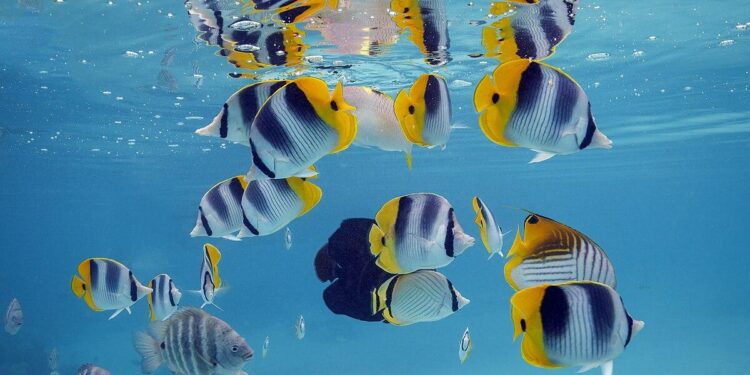In the face of gloomy skies and relentless rain, many find their motivation waning – but the fish in our local waters seem unfazed. As anglers know well, bad weather hardly deters a good catch; in fact, it often signals prime fishing conditions. This resilience serves as a timely reminder for readers of The Inquirer and Mirror: if fish can thrive amid the storm, so can we. This article explores how embracing adverse weather can lead to unexpected rewards, both on the water and in everyday life.
Fish Thrive in Harsh Weather Conditions Revealing Nature’s Resilience
Despite turbulent storms, chilling winds, and shifting currents, fish continue to navigate their aquatic realms with remarkable adaptability. Their survival strategies-ranging from seeking deeper, calmer waters to altering their metabolic rates-underscore an impressive mastery over environmental challenges. This resilience is not just biological but also behavioral, demonstrating nature’s extraordinary capacity to persist and flourish even under pressure. Scientists have observed species employing unique tactics like clustering to conserve heat or adjusting feeding times according to weather patterns, revealing layers of complexity in aquatic ecosystems previously underestimated.
Key adaptations that help fish endure harsh weather include:
- Regulating buoyancy to avoid turbulent surface waters
- Utilizing underwater structures as natural shelters
- Shifting spawning periods to more favorable conditions
- Modifying swimming patterns to conserve energy
| Adaptation | Function | Benefit |
|---|---|---|
| Buoyancy Control | Avoids surface turbulence | Energy conservation |
| Sheltering Behavior | Seeks refuge in structures | Protection from predators |
| Spawning Shift | Adjusts to weather cycles | Increases offspring survival |
| Swimming Pattern Change | Slows movements | Reduces metabolic stress |
Understanding How Weather Affects Fish Behavior to Improve Angling Success
Fish are remarkably adaptable creatures, responding dynamically to shifts in weather conditions. When clouds roll in or a cold front approaches, many species alter their feeding patterns and preferred depths. Overcast skies often reduce light penetration, encouraging fish to venture into shallower waters where food is more abundant. Conversely, bright, sunny days can drive them deeper or into shaded structures, seeking shelter from predators and temperature extremes. Anglers who understand these subtle behavioral shifts can adjust their tactics, such as varying bait presentation or changing fishing spots, to ride the wave of nature’s rhythm rather than fight against it.
Key weather elements influence fish activity in tangible ways:
- Barometric Pressure: Falling pressure typically triggers increased feeding as fish anticipate stormy conditions ahead.
- Wind Direction: Winds can push surface food sources and oxygenated water towards certain banks, concentrating fish and boosting bite rates.
- Temperature Changes: Sudden drops or rises can cause fish to seek stable thermal layers, impacting their location throughout the day.
| Weather Condition | Fish Response | Angler Tip |
|---|---|---|
| Overcast Skies | Fish move into shallow feed zones | Use lighter tackle, fish closer to shore |
| Falling Barometric Pressure | Increased feeding activity | Cast more frequently, vary bait types |
| Strong Winds | Fish concentrate on downwind banks | Focus on windward shores, drift fishing |
Expert Tips for Anglers on Adapting to Inclement Weather and Maximizing Your Catch
When the skies darken and waves grow restless, seasoned anglers know that these conditions can often signal some of the best fishing opportunities. Fish become more active during inclement weather, especially before storms when barometric pressure drops. To take full advantage, experts recommend switching to heavier tackle and brightly colored lures that can cut through murky waters. Additionally, adjusting your fishing schedule to early mornings or late afternoons, when weather tends to be less severe, can greatly increase your chances of a successful catch.
Preparation is key to staying safe and maximizing your haul. Remember to pack extra waterproof gear, maintain clear communication devices, and monitor weather updates frequently. Below is a quick reference table of top gear and techniques proven effective in adverse conditions:
| Tip | Recommended Gear | Effectiveness |
|---|---|---|
| Use weighted lures | Jigs, Spoons | High – improves casting distance |
| Wear layered waterproof clothing | Breathable Rain Jackets | Essential – ensures comfort |
| Fish near structures | Rocky shorelines, submerged trees | Moderate – provides shelter for fish |
| Use polarized sunglasses | UV Protection Lenses | High – reduces water glare |
- Stay vigilant: Unexpected weather shifts require adaptability.
- Optimize your bait choice: Fish feeding patterns change with storms.
- Practice safety first: Always prepare for sudden weather changes.
Future Outlook
As the fish continue to thrive beneath turbulent skies and choppy waters, their resilience serves as a timely reminder for us all. Just as these aquatic creatures navigate storms with steady determination, so too can we face life’s unpredictable weather with calm and perseverance. Whether braving literal storms or the challenges of daily life, the example set by fish underscores a simple truth: bad weather, in any form, need not halt our progress. As The Inquirer and Mirror reports, embracing this mindset may well help us weather our own storms with greater ease.































